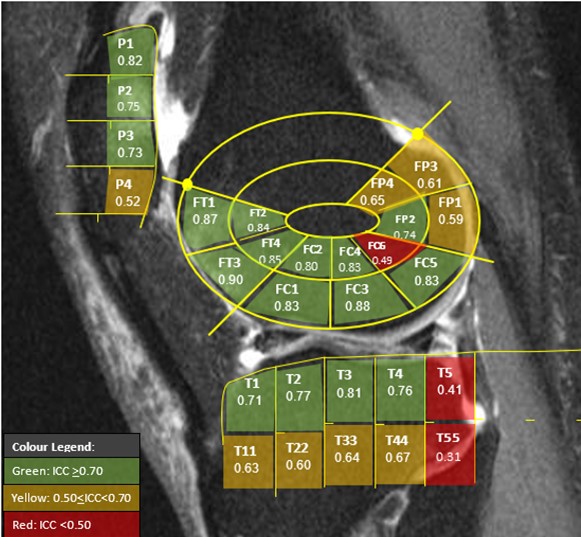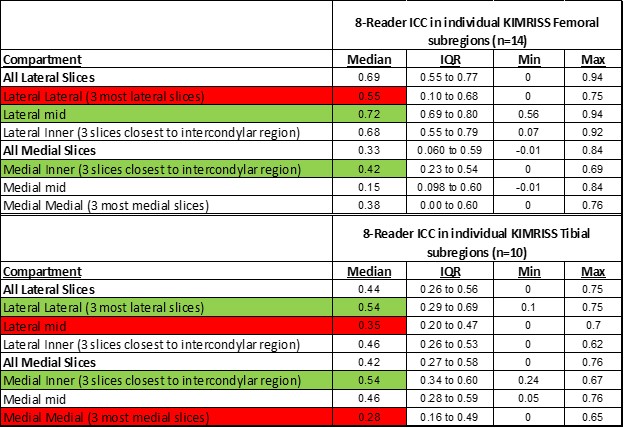Session Information
Session Type: Poster Session C
Session Time: 9:00AM-11:00AM
Background/Purpose: Bone marrow lesions (BML) are an important scoring feature on magnetic resonance imaging (MRI) of knee osteoarthritis (OA), and their presence in certain anatomical locations may be more closely related to various clinical measures than in others. At the same time, anatomical location may impact BML scoring reliability. The Knee Inflammation MRI Scoring System (KIMRISS) scores BML from fluid-sensitive sagittal MRI1. Readers place ready-made overlays onto scorable portions of the femur, tibia, and patella, demarcating medial, intercondylar, and lateral knee compartments. These overlays divide each scorable region into smaller grid squares which are evaluated for presence of BML on each slice. We aimed to evaluate 3-dimensional patterns of regional variation in inter-rater reliability for BML within these sagittally-placed KIMRISS grid elements when divided into subsections across the coronal plane. This granular analysis serves as a precursor to further study of the relationship of precise BML location to clinical measures and outcomes, as reliable data is required to ensure validity of such analyses.
Methods: MRI from 61 patients in the Osteoarthritis Initiative (OAI) dataset were scored by 8 trained readers using KIMRISS. Each grid overlay region in the femur and tibia (14 and 10 regions, respectively) was divided into 6 equal subregions medially to laterally, excluding the intercondylar region.We calculated an overall 8-reader interclass correlation coefficient (ICC) for each subregion and generated a 3D segmentation model of the knee to visualize variation in ICCs.
Results: Before any subdivision in the coronal plane, ICCs ≥ 0.70 were achieved in 61% of grid regions (Figure 1). Highest reliability was found trochlear region of the femur (ICCs 0.84-0.90), while lowest ICCs occurred in a small interior region of the femur [mean (SD) ICC=0.49 (0.26)] and the two posteriormost tibial regions [mean (SD) ICC=0.41 (0.26) and 0.31 (0.33)]. After further subdividing regions medially to laterally, highest overall reliability amongst all KIMRISS grid squares occurred in the central slices of the lateral compartment of the femur (median ICC=0.72) and the innermost slices of the medial compartment of the tibia (median ICC=0.42). (Figure 2, Table 1). Lowest overall reliability occurred in the central slices of the medial compartment of the femur (median ICC=0.15) and the medialmost slices of the medial compartment of the tibia (median ICC= 0.28)
Conclusion: While reduced ICCs are to be expected across the board in subdivided scoring regions compared to larger summed regions, this analysis highlights differences in inter-rater reliability over 3 dimensions of the knee. Any analysis of the relationship of clinical variables to precise BML location should consider the degree of scoring reliability at the scoring locations entered into the model. Certain regions may need to be excluded or enlarged to achieve inter-rater consistency.
To cite this abstract in AMA style:
Wichuk S, Maksymowych W, Paschke J, Hareendranathan A, Jaremko J. 3-Dimensional Regional Variation in Inter-rater Reliability of Bone Marrow Lesion Scoring in the Knee [abstract]. Arthritis Rheumatol. 2023; 75 (suppl 9). https://acrabstracts.org/abstract/3-dimensional-regional-variation-in-inter-rater-reliability-of-bone-marrow-lesion-scoring-in-the-knee/. Accessed .« Back to ACR Convergence 2023
ACR Meeting Abstracts - https://acrabstracts.org/abstract/3-dimensional-regional-variation-in-inter-rater-reliability-of-bone-marrow-lesion-scoring-in-the-knee/



